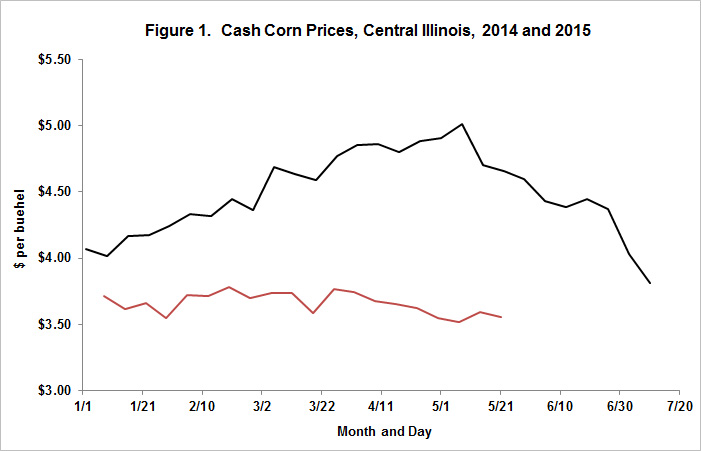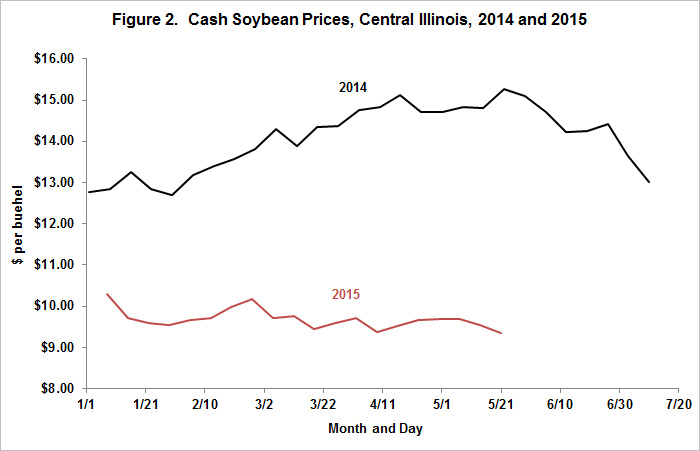Marketing Gains Impacts on 2014 and 2015 Net Incomes on Grain Farms
Many farms’ net income statements are prepared using modified cost principles. Grain revenues typically includes crop sales and changes in grain inventory values between beginning and ending balance sheets. Much of the grain produced and unpriced in 2013 was valued on the end-of-year 2013 balance sheet at prices lower than that grain was sold in 2014. This resulted in sizable marketing gains, which could be significant contributors to 2014 net incomes on many farms. Marketing gains likely will not be large contributors to income in 2015. Marketing losses are likely for grain produced in 2014 and not priced until 2015.
Illustration of 2014 Marketing Gains
Take a farm that produced 200 bushels of corn in 2013 and sold 75 of those bushels in 2013. The remaining 125 bushels were unpriced and held in inventory on December 31, 2013. The 75 bushels were sold at $4.69 and the inventory was valued at $4.10 per bushel on December 31, 2013. The value of the 125 bushels on the 2013 balance sheet was $513 (125 bushels x $4.10). Revenue from 2013 grain shown on the 2013 income statement reflected $352 of crop sales on new (75 bushels x $4.69) plus $513 of grain in inventory, for total revenue from 2013 corn of $865 per acre.
In 2014, the 125 bushels were sold at a price of $4.50 per bushel. The $4.50 sales price is $.40 per bushel higher than the $4.10 inventory price. This would result in a marketing gain of $50 per acre (125 bushels x $.40 per bushel).
Cash Grain Prices in 2014 and 2015
At the end of 2013, cash grain prices were near $4.10 and many farmers likely valued grain near $4.10 per bushel on the 2013 end-of-year balance sheets. Corn prices increased during the first months of 2014, reaching highs of over $5.00 per bushel (see Figure 1). Depending on timing and amount of corn sales, farmers could have averaged $.40 to $.50 per bushel more than the $4.10 inventory value. Unpriced corn inventory of 125 bushels could have resulted in $40 to $75 per acre in marketing gains. Of course the amount of marketing gain depends on unpriced grain in 2013 year-end inventory and the price placed on this inventory, and the timing and amount of cash sales in 2014.

Large marketing gains for corn are not likely in 2015. At the end of 2014, corn was selling near $3.75 per bushel, and many may have used $3.75 for valuing corn on the end-of-year 2014 balance sheet. Corn prices have been stable to slightly decreasing in 2014 (see Figure 1). Many farms could have negative market gains on corn.
A $12.75 per bushel price could have been justified for valuing soybean inventory at the end of 2014. During the first months of 2014, soybean prices increased reaching highs of over $15 per bushel (see Figure 2). Marketing gains in 2014 of $1.00 per bushel are possible. If 25 bushels of unpriced soybeans were in the end-of-year inventory, marketing gains of $20 to $30 per acre are possible for soybeans.

Similar to corn, marketing gains are unlikely for soybeans in 2015. Cash soybean prices were near $10.25 per bushel at the beginning of 2015. Since then, soybean prices have decreased to around 9.35 per bushel (see Figure 2). Many farmers could have marketing losses in 2015 for soybeans produced in 2014 and unpriced at the end of 2015.
Summary
On many farms, marketing gains on crops produced in 2013 and priced in 2014 were a significant component of 2014 net income. Gains possibly averaged around $30 per acre across corn and soybeans. These marketing gains could account for around 30% of 2014 net incomes on many farms. Marketing gains will not be a major contributor to 2015 net income. In 2015, net incomes for grain farms likely will be considerably below 2014 incomes because marketing gains are not likely in 2014.
Many farms had relatively good net income in 2014. If marketing gains contributed to strong 2014 net income, the 2014 net income may not indicate the extent to which commodity price decreases will impact incomes in 2015.
Disclaimer: We request all readers, electronic media and others follow our citation guidelines when re-posting articles from farmdoc daily. Guidelines are available here. The farmdoc daily website falls under University of Illinois copyright and intellectual property rights. For a detailed statement, please see the University of Illinois Copyright Information and Policies here.







